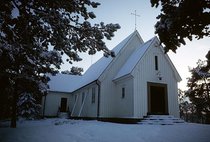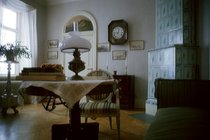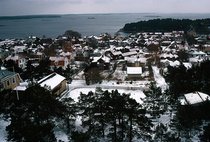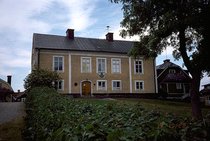Sandhamn
Sandhamn is a centre of small boat activity, and can proudly present its beautiful cultural heritage and experiences of the natural world. Since the 18th century, the island has been a pilot and customs post, a sentinel of society at the Baltic Sea
The ocean and the horizon give a special character to Sandhamn, or Sandön, which is the correct name for the island. “The natural beauty of Sandhamn, surrounded on three sides by water and on the fourth by the ocean”, as August Strindberg wrote in 1873. Sandön, together with Runmarö, Skarprunmarn, Vindalsö and Eknö, was part of a donation that King Magnus Ladulås presented to the St. Clara monastery in Stockholm, around 1280. In tax documents from the 16th century, the island is placed under the village of Eknö. At this time Sandön was probably uninhabited, and used solely as grazing.
Pilots and customs men
A pilot station was established here towards the end of the 17th century, and during the 18th and 19th centuries the inhabitants were mainly employed as pilots, customs men and innkeepers. The imposing stone-built customs house that dominates the harbour was designed by royal architect Carl Hårleman, and built in 1752. For several years during the middle of the 19th century, poet and artist Elias Sehlstedt was head of the customs operations on Sandön.
The growth of steamboat traffic after the 1860s brought summer guests, and it was not long before wealthy middle-class families from Stockholm began to build summer residences here. Authors and artists were attracted to the island, including such celebrities as author and playright August Strindberg and painter Anders Zorn. Towards the end of the 19th century, Sandhamn developed into a centre of leisure sailing, with sailing races and regattas every summer. The activities have grown enormously since that time, and now culminate each year with the Gotland Runt weekend.
Beaches and sand quarries
The village, as the area around the harbour is normally called, consists of buildings that mix old-fashioned cottages from the pilot and customs era with summer villas from the turn of the century round 1900.
The island, which is 3 km long and 1 km wide, consists of sand and more sand, interrupted here and there by scattered rock outcrops. On the southern side of the island, half an hour’s walk from the village, there is the popular beach Trouville.
The village is framed to the south by the remains of a sand quarry that was a secondary employer on the island during the 20th century. As long as the sailing vessels were in use, sand was sold as ballast, and during the first half of the 20th century also as building material for Stockholm.
Liquor smuggling
The small 18th century houses Bryggstugan and Tullvaktstugan house a museum that is run by the “Sandhamns vänner” society. On display are artefacts from the period when Sandhamn was a customs and pilot station, and from the fishing, hunting and smuggling period of the 1920s.
Sandhamns Värdshus is one of the oldest inns in Sweden, and claims that it has been continuously open since 1672.
Links
Regular boat connections with Stockholm.




